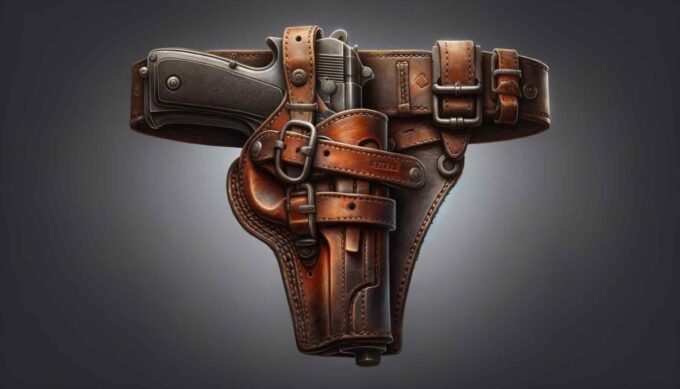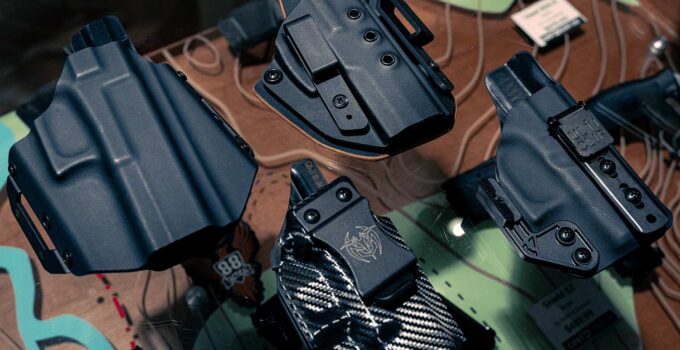Choosing the right holster for concealed carry is fundamental as it is directly connected to safety and practicality. Properly securing a firearm not only ensures personal safety but also safeguards those around you.
Whether a seasoned carrier or a newcomer to concealed carry, understanding these key elements is fundamental for a confident and responsible carrying experience. So, let’s dive straight in!
In this article, the responsible firearm industry platform Arms Directory delves into crucial considerations, emphasizing factors that contribute to a harmonious blend of comfort, accessibility, and, most importantly, the safe and secure concealment of your gun.
What Are Gun Holsters?
A gun holster is where you put your firearm when you wear it and are not using it. Usually attached to your clothing, it is great for everyday life/work as it keeps the gun concealed and safely stored. Although there are different types of gun holsters out there, you shouldn’t ignore the importance of getting a reliable one. After all, you don’t want everyone around you to see you constantly checking for it to make sure it is there and it is securely attached.
When choosing a gun holster, it’s important to consider factors such as comfort, accessibility, and durability. A poorly designed or low-quality holster can be uncomfortable to wear, difficult to draw from, and may not securely retain the firearm. On the other hand, a reliable and well-fitting holster can provide peace of mind, knowing that your gun is securely attached and concealed.
For example, if you’re a police officer working in plain clothes, an OWB holster with a retention mechanism can keep your firearm securely attached to your belt while allowing quick access when needed. Meanwhile, if you’re a concealed carry permit holder going about your daily life, an IWB holster can provide deeper concealment and increased comfort for extended wear.
In any case, investing in a reliable gun holster from a reputable manufacturer is essential for ensuring the safety and effectiveness of your firearm carry setup.
Gun Holster Common Terms

Source: taskandpurpose.com
To navigate the realm of concealed carry holsters effectively, it’s crucial to grasp common terms integral to holster design and functionality. Retention, a key term, refers to the holster’s ability to secure the firearm, impacting both safety and accessibility.
Understanding the distinction between passive and active retention is vital—passive relies on friction, while active involves mechanisms like thumb breaks. Cant, another essential term, determines the holster’s angle, influencing draw comfort and concealability. Similarly, ride height, denoting how high the gun sits on the belt, affects both concealment and ease of access.
Opting for a holster with an adjustable cant and ride height allows customization, enhancing concealability and facilitating a more natural draw. Exploring these terms empowers firearm carriers to make informed decisions, ensuring their chosen holster aligns seamlessly with their needs and preferences.
Types of Concealed Carry Holsters
Choosing the right concealed carry holster is a critical decision for firearm owners, and understanding the different types is essential to making an informed choice.
Inside the Waistband (IWB) holsters are popular for their discreteness. They are worn inside the pants, offering excellent concealment. While they might be slightly less comfortable than outside-the-waistband options, IWB holsters provide better concealability.
Outside the Waistband (OWB) holsters are worn on the outside of the pants, making them more comfortable than IWB options. However, they are generally less discreet, as the firearm sits outside the clothing. OWB holsters are great for open carry where permitted and offer quick access.
Shoulder holsters are worn over the shoulder, with the firearm positioned under the armpit. They distribute the weight of the firearm evenly, providing comfort. However, they may require additional layers for effective concealment.
Each type has its pros and cons, and the best choice depends on personal preferences and the specific firearm. Consider factors such as comfort, accessibility, and concealability. It’s crucial to choose a holster that fits both the firearm and the carrier’s preferences.
IWB holsters are excellent for those prioritizing concealment, especially in warmer climates where lighter clothing is common. OWB holsters offer comfort and quick access, making them suitable for open carry or colder weather when concealment is less critical. Shoulder holsters provide an alternative for those who find hip holsters uncomfortable.
Material and Construction

Source: ssusa.org
The material and construction of a concealed carry holster play a crucial role in its performance, durability, and overall effectiveness. When choosing a holster, it’s essential to prioritize high-quality materials and construction to ensure the safety and security of your firearm.
Durable and reliable materials are paramount in holster selection. Leather, nylon, and Kydex are common materials used, each with its unique characteristics.
1. Leather
Leather holsters are known for their classic appearance and comfort. They conform to the shape of the firearm over time, providing a snug fit. However, leather holsters may require a break-in period, and they can be affected by environmental factors like moisture. Regular maintenance, such as conditioning, is crucial to preserve the leather’s integrity.
2. Nylon
Nylon holsters are lightweight and often more affordable. They are resistant to moisture and can be more forgiving in terms of fit. However, they may lack the rigidity of other materials, impacting retention. Quality stitching and reinforced areas are essential in nylon holsters to ensure longevity.
3. Kydex
Kydex holsters are made from a thermoplastic material known for its durability and rigidity. They offer excellent retention and trigger guard coverage. Kydex holsters are resistant to moisture and maintain their shape over time. They are less affected by environmental conditions compared to leather. However, some users find them less comfortable than leather options.
Factors Influencing the Durability and Longevity of A Holster Include Stitching, Retention, and Fit

Source: medium.com
Stitching: High-quality stitching is crucial to a holster’s longevity. Reinforced and double-stitched areas contribute to overall durability. Check for consistent stitching and any signs of fraying or weakness.
Retention: Proper firearm retention is essential for safety. The holster should securely hold the firearm in place, preventing accidental dislodging. Adjustable retention screws are a valuable feature, allowing users to customize the level of retention.
Fit: A well-fitted holster ensures the firearm is secure and easily accessible. A proper fit contributes to comfort and helps prevent unnecessary wear on the holster and firearm.
Conclusion
The choice between leather, nylon, and Kydex materials impacts durability and performance, with factors like stitching, retention, and fit influencing the overall quality. By adhering to these considerations, you can make an informed decision for a secure, comfortable, and reliable concealed carry holster.







